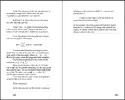Here's some of the text from the book. It gives you an idea of the level of complexity. Looks legitimate to me!
------ copied from the book ---
[Saito: And particle entanglement allows you to manipulate both sides of the wormhole, even when they are outside of the sphere?]
Yes. Quantum engineers in my time call this “reflection”, because the manipulations to the electromagnetic field containing the quantum- entangled ions within the EPM containment unit are reflected in the singularity’s event horizons, even though one of those horizons, the distant horizon, might be thousands of kilometers away or 100 years in the past. Einstein called the phenomenon “spooky action at a distance”.
[Saito: So, there really is no negative energy keeping your singularity open?]
Correct. Once the micro-singularity has been formed, the tensor’s latitudinal arms manipulate the electromagnetic field against the singularity. It prevents the singularity from being pushed out of space time. It separates and couples the singularity at the quantum level and then repositions the two horizons outside of the containment unit.
[Saito: How do you resolve the averaged null energy violation of an object moving through your wormhole?]
Violation of the averaged null energy condition is actually a prerequisite for all traversable wormholes, but that does not make such transit impossible. There must be infinite null geodesics passing through the wormhole, with tangent vector O and affine parameter , along which:
(there is some complex formula here which I can't copy/paste to the forum)
Objects can pass through the directly coupled boundaries. The causal structure of the singularity’s manifold is modified as a result, changing the commutation relations along null geodesics through the tunnel and making them no longer achronal. For the same reason, a causal horizon extending through the wormhole intersects itself, removing the piece with divergent area. Hence the above impossibility results do not apply. In effect, what you thought was impossible, is possible under the right tensor model.
[Saito: So, no negative energy is used, but you achieve the same result as if you had employed negative energy.]
That’s a fair statement. The energy in our configuration is similar to the Casimir effect, which, as you know, is a negative energy principal. It is similar in that the interaction between the boundaries implies that the radial direction is effectively a
compact circle."
... this gives you an idea of the technical complexity. It all looks legit to me!
 @Harte What do you make of those calculations?
@Harte What do you make of those calculations? ..Last edited:
..Last edited: